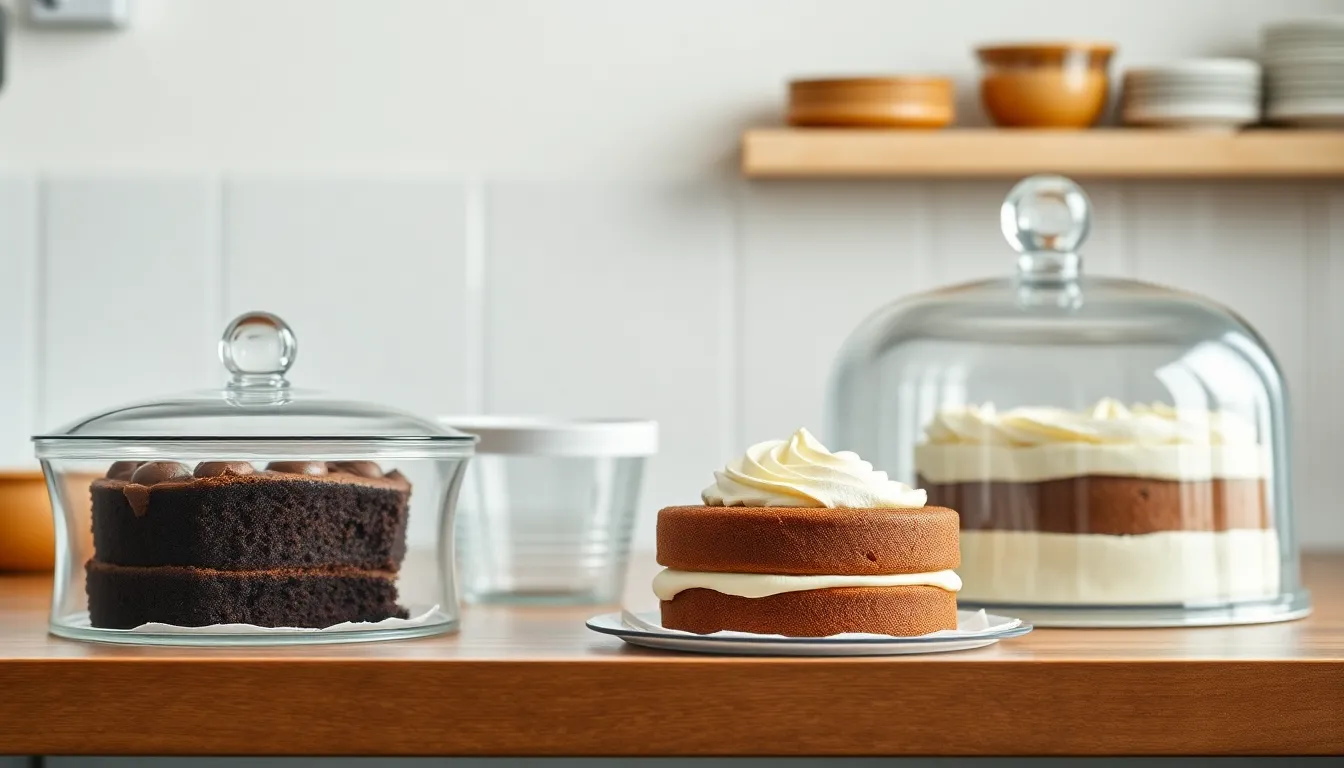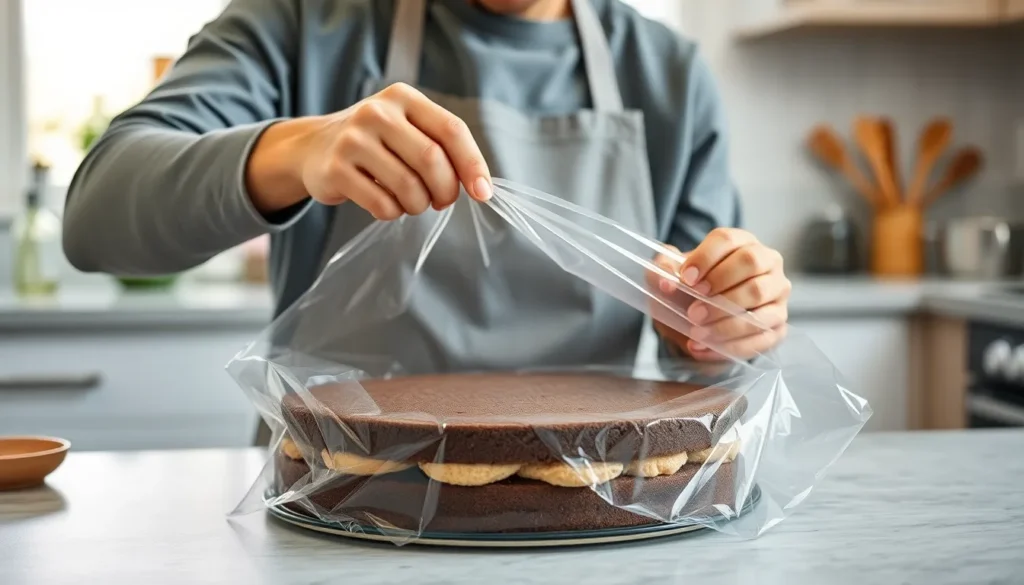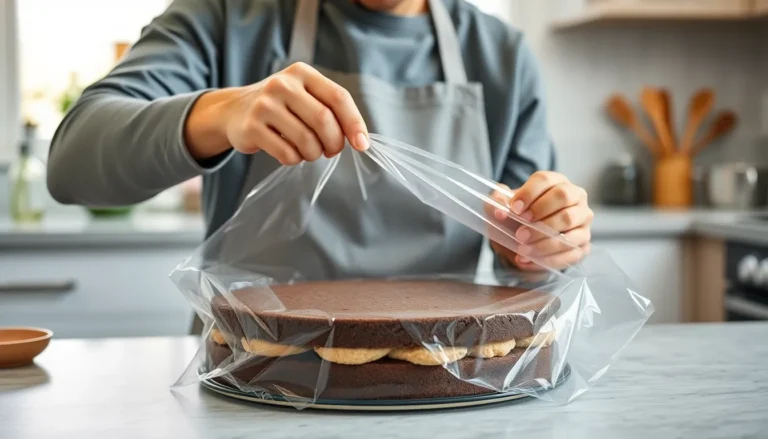Table of Contents
ToggleCake lovers rejoice! The joy of sinking a fork into a perfectly moist slice is unmatched, but what happens when that cake needs to survive beyond the first glorious bite? Storing cake isn’t just a matter of tossing it in the fridge and hoping for the best. With the right techniques, that delectable dessert can stay fresh and scrumptious, turning every day into a celebration.
Importance of Cake Storage
Proper cake storage plays a crucial role in maintaining freshness and flavor. Storing cake incorrectly can lead to dryness, spoilage, or unwanted texture changes. Different storage methods suit various types of cakes, ensuring optimal taste and quality.
Using the right materials protects cakes from air exposure and contamination. Airtight containers or plastic wrap effectively keep moisture in, preventing cakes from becoming stale. Refrigeration offers benefits for certain cakes, particularly those with perishable fillings like cream or fruit.
Monitoring temperature during storage helps maintain ideal conditions. Cakes stored at room temperature often allow for better flavor expression, as cold temperatures can dull taste. If a cake contains frosting, chilled storage can prevent melting but should be done with caution.
Layer cakes require careful handling to avoid damage. Placing parchment paper between layers prevents sticking, preserving the cake’s form. Additionally, shielding cakes from strong odors in the fridge ensures that their original flavors remain intact.
When it comes to longer-term storage, freezing presents a viable option. Freezing allows cakes to remain fresh for up to three months. Wrapping cakes securely in plastic wrap and aluminum foil prevents freezer burn, protecting both texture and taste.
Different cakes, such as sponge or pound varieties, might need specific care methods. Understanding each cake’s unique requirements safeguards its quality. Implementing these storage techniques maximizes enjoyment and ensures that every slice remains delicious and fresh.
Types of Cake Storage

Knowing how to store cakes correctly ensures freshness and flavor retention. Different storage methods accommodate various cake types.
Short-Term Storage
Short-term storage involves quickly preserving cakes for immediate enjoyment. Cakes stored at room temperature can maintain moisture, especially when placed in airtight containers. Covering cakes with plastic wrap or a cake dome protects them from air exposure and keeps them moist. Layer cakes require careful handling, often needing parchment paper between layers to prevent sticking. When cakes contain perishable fillings, refrigeration helps maintain freshness, though monitoring the temperature prevents changes in texture. For chocolate and buttercream cakes, storing them at room temperature improves flavor. Proper short-term storage allows cakes to remain delightful for days.
Long-Term Storage
Long-term storage ensures cakes stay fresh for extended periods. Freezing cakes extends their lifespan up to three months when wrapped securely in plastic wrap or aluminum foil. Removing excess air is crucial to prevent freezer burn. For best results, cakes should be partially thawed in the refrigerator before serving, enhancing texture and flavor. Unfrosted cakes freeze better than frosted ones, as frosting can alter consistency during thawing. Layering cakes with parchment paper before wrapping aids separation while frozen. Learning appropriate long-term storage methods guarantees every slice remains delicious, even after weeks.
Techniques for Proper Cake Storage
Proper cake storage techniques help maintain freshness and flavor, extending the enjoyment of each slice. Effective methods prevent dryness and spoilage.
Wrapping and Sealing
Wrap cakes in plastic wrap or aluminum foil to protect them from air exposure. Ensure the wrapping covers the entire surface to lock in moisture. Avoid using wax paper, as it can absorb moisture and alter texture. For layered cakes, place parchment paper between the layers to prevent sticking. Sealing tightly around the edges enhances protection, maintaining the cake’s delightful taste.
Choosing the Right Container
Select airtight containers for short-term storage to keep cakes fresh. Containers should fit the cake snugly without excessive space, minimizing air exposure. Glass containers offer visibility, while plastic options are lightweight and portable. For large cakes, consider using cake domes or specially designed cake carriers. Opt for containers that prevent crushing when stacking, preserving the cake’s appearance. Proper container choice supports cake longevity while maintaining taste and texture.
Common Mistakes in Cake Storage
Improper cake storage leads to flavor loss and texture issues. Many people place cakes directly in the fridge, assuming this keeps them fresh. Storing cakes at room temperature in airtight containers often preserves moisture better. Layer cakes frequently require parchment paper between layers, but this step is often overlooked. Not wrapping cakes securely can allow air exposure, causing them to dry out. When cakes have perishable fillings, refrigeration is necessary, yet tracking the temperature can be forgotten.
Confusion arises about the best materials for wrapping cakes. Using wax paper is a common mistake; it can alter the cake’s texture negatively. Frosted cakes tend to suffer in the freezer, making unfrosted alternatives a better choice. Failing to remove excess air from wrapping allows for freezer burn, compromising quality. Thawing methods also play a crucial role; individuals often thaw cakes at room temperature instead of in the refrigerator.
Choosing the right storage container impacts cake longevity significantly. Snug-fitting airtight containers help minimize air exposure, but these are not always utilized. Cake domes or carriers provide excellent options for larger cakes, ensuring they stay fresh. Understanding the specific storage needs for different cake types ensures quality maintenance. Awareness of these common mistakes leads to a more satisfying cake experience, keeping every slice delightful and fresh.
Proper cake storage is essential for maintaining flavor and freshness. By utilizing the right techniques and materials, anyone can extend the life of their favorite desserts. It’s important to remember that not all cakes require the same storage methods. Room temperature may be ideal for many, while others benefit from refrigeration or freezing.
Avoiding common mistakes like using wax paper or neglecting to wrap cakes securely will help preserve moisture and texture. With a little attention to detail, cakes can remain delightful and ready to enjoy long after they’ve been baked. Embracing these storage practices ensures that every slice is just as delicious as the first.




